-
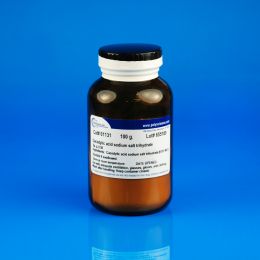 Cacodylic acid, sodium salt trihydrateCatalog Number 01131
Cacodylic acid, sodium salt trihydrateCatalog Number 01131Dissolve in distilled or deionized water heated to 60°C, under a hood.
(Sodium cacodylate)
-
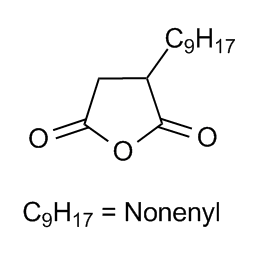 Nonenyl Succinic Anhydride (NSA)Catalog Number 01542
Nonenyl Succinic Anhydride (NSA)Catalog Number 01542Liquid anhydride for curing low viscosity embedding resin for E.M., particularly used in Spurr formulations. Our material is specially distilled for E.M. applications and was developed in conjunction with Dr. Spurr.
-
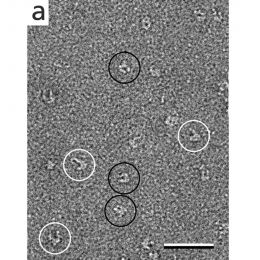 Uranyl FormateCatalog Number 24762
Uranyl FormateCatalog Number 24762Electron dense, heavy metal compounds of uranium, tungsten and molybdenum have long been utilized for "negative staining" in electron microscopy. As demand for ultra-fine structure in biomolecules has increased, new fine grain structure materials are required.
-
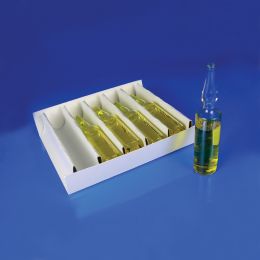 Ruthenium tetroxide, 0.5% stabilized aqueous solutionCatalog Number 18253
Ruthenium tetroxide, 0.5% stabilized aqueous solutionCatalog Number 18253Useful as a staining agent for electron microscopy of polymers, as well as a fixative for biological samples. Ruthenium tetroxide penetrates tissue very slowly, reacting strongly with proteins, glycogen and monosaccharides.
-
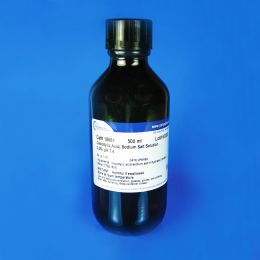 Cacodylic acid, sodium salt, solution, 0.2M, pH 7.4Catalog Number 18661
Cacodylic acid, sodium salt, solution, 0.2M, pH 7.4Catalog Number 18661Buffer for fixatives for light and electron microscopy; e.g., osmium tetroxide, formaldehyde, glutaraldehyde, Karnovsky’s fixative.
-
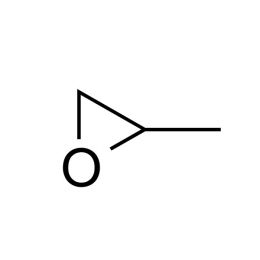 Propylene OxideCatalog Number 00236
Propylene OxideCatalog Number 00236Solvent used in the last stage of dehydration of tissue for epoxy embedding.
-
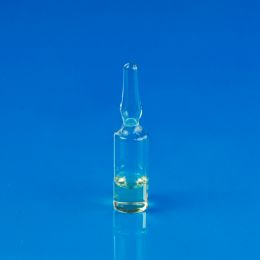 Osmium tetroxide, 4% solution - 20 x 2mlCatalog Number 0972A
Osmium tetroxide, 4% solution - 20 x 2mlCatalog Number 0972APost fix and stain for E.M. The solution is microfiltered and features exact concentration, no cross contamination, and has excellent stability when kept cold and in the dark. Supplied in pre-scored sealed ampoules with each ampoule having its own ampoule cracker. Used for post staining of DAB/peroxidase to darken and retain stain for long term storage.
-
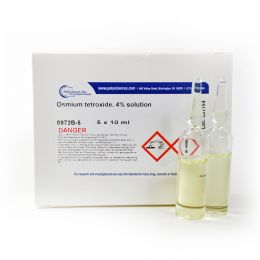 Osmium tetroxide, 4% solution - 5 x 10mlCatalog Number 0972B
Osmium tetroxide, 4% solution - 5 x 10mlCatalog Number 0972BPost fix and stain for E.M. The solution is microfiltered and features exact concentration, no cross contamination, and has excellent stability when kept cold and in the dark. Supplied in pre-scored sealed ampoules with each ampoule having its own ampoule cracker. Used for post staining of DAB/peroxidase to darken and retain stain for long term storage,
-
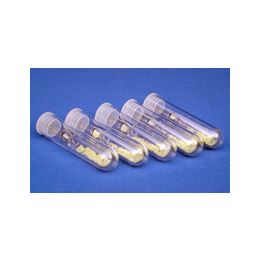 Osmium tetroxide, crystalline, 99.95% - 10x1/4gCatalog Number 0223D
Osmium tetroxide, crystalline, 99.95% - 10x1/4gCatalog Number 0223DPost fix and stain for E.M. Supplied in pre-scored ampoules sealed in plastic bags. The ampoules are label free to avoid cleaning prior to preparation of solutions. Each ampoule is equipped with an ampoule cracker.
-
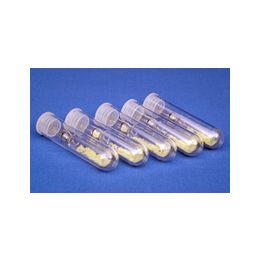 Osmium tetroxide, crystalline, 99.95% - 5x1gCatalog Number 0223A
Osmium tetroxide, crystalline, 99.95% - 5x1gCatalog Number 0223APost fix and stain for E.M. Supplied in pre-scored ampoules sealed in plastic bags. The ampoules are label free to avoid cleaning prior to preparation of solutions. Each ampoule is equipped with an ampoule cracker.
-
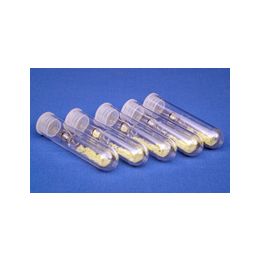 Osmium tetroxide, crystalline, 99.95% - 10x1/2gCatalog Number 0223C
Osmium tetroxide, crystalline, 99.95% - 10x1/2gCatalog Number 0223CPost fix and stain for E.M. Supplied in pre-scored ampoules sealed in plastic bags. The ampoules are label free to avoid cleaning prior to preparation of solutions. Each ampoule is equipped with an ampoule cracker.
-
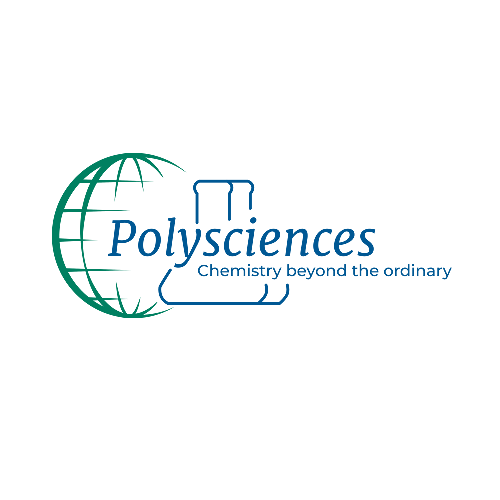 Osmium tetroxide, 4% solution - 20 x 10mlCatalog Number 0972C
Osmium tetroxide, 4% solution - 20 x 10mlCatalog Number 0972CPost fix and stain for E.M. The solution is microfiltered and features exact concentration, no cross contamination, and has excellent stability when kept cold and in the dark. Supplied in pre-scored sealed ampoules with each ampoule having its own ampoule cracker. Used for post staining of DAB/peroxidase to darken and retain stain for long term storage,
-
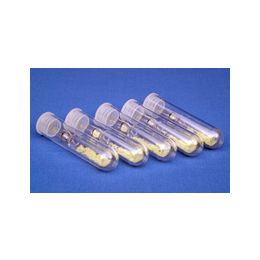 Osmium tetroxide, crystalline, 99.95% - 10x1gCatalog Number 0223B
Osmium tetroxide, crystalline, 99.95% - 10x1gCatalog Number 0223BPost fix and stain for E.M. Supplied in pre-scored ampoules sealed in plastic bags. The ampoules are label free to avoid cleaning prior to preparation of solutions. Each ampoule is equipped with an ampoule cracker.
-
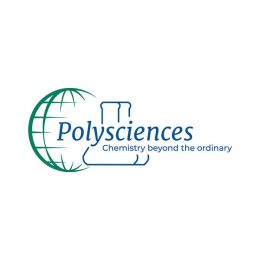 Osmium ammine-BCatalog Number 21033
Osmium ammine-BCatalog Number 21033Stable DNA stain.
-
![Formvar 15/95 (Poly[vinyl formal])](https://www.polysciences.com/media/catalog/product/placeholder/default/PSIgreenblueoutlines_4.png) Formvar 15/95 (Poly[vinyl formal])Catalog Number 00631
Formvar 15/95 (Poly[vinyl formal])Catalog Number 00631Powder used to make support films on E.M. grids for fragile samples. Polymer contains cyclic acetal units, some residual hydroxyl groups.
Hydroxyl content 5.0-6.5%; acetate 9.5-13.0 Formal 82%
-
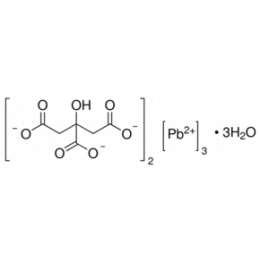 Lead Citrate, Powdered Fines Grade (< 5 µm) (only for sale within the US)Catalog Number 25350
Lead Citrate, Powdered Fines Grade (< 5 µm) (only for sale within the US)Catalog Number 25350The most popular lead stain for EM applications. Carbonate free material.
Particle Size: >90% particle size is less than ca. 5 µm
-
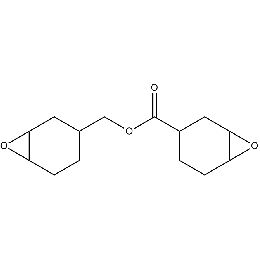 ERL-4221 (3,4-Epoxycyclohexanemethyl 3,4-epoxycyclohexanecarboxylate)Catalog Number 24738
ERL-4221 (3,4-Epoxycyclohexanemethyl 3,4-epoxycyclohexanecarboxylate)Catalog Number 24738ERL-4221 is a cycloaliphatic, diepoxy functional organic compound that is a useful building block in the production of semi-hard to hard cured epoxy resins. It is incompatible with amines, acids and strong bases and will cure to form a resinous product. ERL-4221 is often used in manufacture of plastic embedding kits for electron microscopy.
-
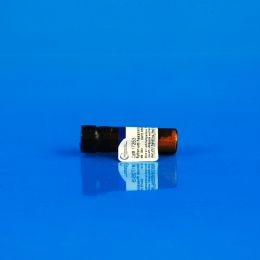 Ruthenium hexammine trichlorideCatalog Number 17253
Ruthenium hexammine trichlorideCatalog Number 17253Electron microscopy stain.
-
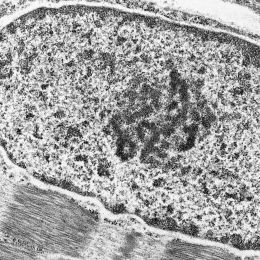 Uranyl Acetate 98%, ACS ReagentCatalog Number 21447
Uranyl Acetate 98%, ACS ReagentCatalog Number 21447Uranyl acetate improves tissue penetration and contrast without affecting immunolabeling. Useful as positive or negative stain for thin sections.
-
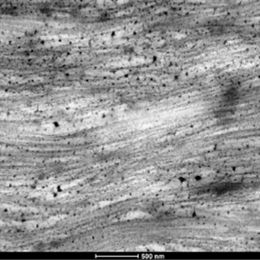 Blue Platinum EM StainCatalog Number 26001
Blue Platinum EM StainCatalog Number 26001An EM stain that can replace uranyl acetate in many cases tor staining TEM thin sections. An excellent alternative to uranyl acetate in your lab cannot use radioactive compounds.
-
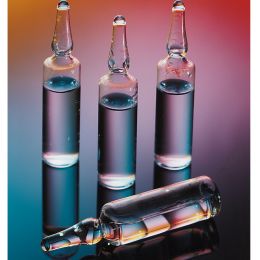 Osmium tetroxide, 2% solution - 10 x 2mlCatalog Number 23310
Osmium tetroxide, 2% solution - 10 x 2mlCatalog Number 23310Post fix and stain for E.M. Microfiltered solution in pre-scored sealed ampoules with each ampoule having its own ampoule cracker.
-
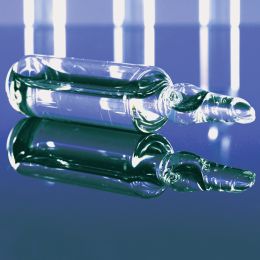 Osmium tetroxide, 2% solution - 10 x 5mlCatalog Number 23311
Osmium tetroxide, 2% solution - 10 x 5mlCatalog Number 23311Post fix and stain for E.M. Microfiltered solution in pre-scored sealed ampoules with each ampoule having its own ampoule cracker.
EM Reagents
